Genetic Dissection of Germinability under Low Temperature by Building a Resequencing Linkage Map in japonica Rice
Abstract
1. Introduction
2. Results
2.1. Phenotypic Variation among the Parent and RIL Populations
2.2. Bin Map Construction and Comparison of the Physical Map to the Genetic Map
2.3. The Quality and Accuracy of the Bin Map
2.4. QTL Analysis of Low-Temperature Germinability
2.5. Fine Mapping and Candidate Gene Prediction for qLTG6
2.6. Expression Analysis of LOC_Os06g01320
3. Discussion
4. Materials and Methods
4.1. Plant Materials
4.2. Preparation of Seeds for the Germination Test
4.3. Evaluation of Germinability under Cold Stress
4.4. DNA Extraction, Re-Sequencing, and SNP Calling
4.5. Genotyping and Construction Bin Map
4.6. QTL Mapping for Low-Temperature Germinability
4.7. qRT-PCR and Expression Analysis
Author Contributions
Funding
Conflicts of Interest
References
- Qian, Q. Genomics assisted germplasm improvement. J. Integr. Plant Biol. 2018, 60, 82–84. [Google Scholar] [CrossRef]
- Zhang, Q.; Chen, Q.; Wang, S.; Hong, Y.; Wang, Z. Rice and cold stress methods for its evaluation and summary of cold tolerance-related quantitative trait loci. Rice 2014, 7, 24. [Google Scholar] [CrossRef] [PubMed]
- Zhang, Z.; Li, J.; Pan, Y.; Li, J.; Zhou, L.; Shi, H.; Zeng, Y.; Guo, H.; Yang, S.; Zheng, W.; et al. Natural variation in CTB4a enhances rice adaptation to cold habitats. Nat. Commun. 2017, 8, 14788. [Google Scholar] [CrossRef] [PubMed]
- Lu, G.; Wu, F.; Wu, W.; Wang, H.; Zheng, X.; Zhang, Y.; Chen, X.; Zhou, K.; Jin, M.; Cheng, Z.; et al. Rice LTG1 is involved in adaptive growth and fitness under low ambient temperature. Plant J. 2014, 78, 468–480. [Google Scholar] [CrossRef] [PubMed]
- Liu, C.; Wang, W.; Mao, B.; Chu, C. Cold stress tolerance in rice: Physiological changes, molecular mechanism, and future prospects. Hereditas (Beijing) 2018, 40, 171–185. [Google Scholar]
- Wang, Z.; Wang, J.; Wang, F.; Bao, Y.; Wu, Y.; Zhang, H. Genetic control of germination ability under cold stress in rice. Rice Sci. 2009, 16, 173–180. [Google Scholar] [CrossRef]
- Shi, Y.; Ding, Y.; Yang, S. Molecular regulation of CBF signaling in cold acclimation. Trends Plant Sci. 2018, 23, 623–637. [Google Scholar] [CrossRef]
- Yonemaru, J.; Yamamoto, T.; Fukuoka, S.; Uga, Y.; Hori, K.; Yano, M. Q-TARO: QTL annotation rice online database. Rice 2010, 3, 194. [Google Scholar] [CrossRef]
- Fujino, K.; Sekiguchi, H.; Matsuda, Y.; Sugimoto, K.; Ono, K.; Yano, M. Molecular identification of a major quantitative trait locus, qLTG3-1, controlling low-temperature germinability in rice. Proc. Natl. Acad. Sci. USA 2008, 105, 12623–12628. [Google Scholar] [CrossRef]
- Wang, X.; Zou, B.; Shao, Q.; Cui, Y.; Lu, S.; Zhang, Y.; Huang, Q.; Huang, J.; Hua, J. Natural variation reveals that OsSAP16 controls low-temperature germination in rice. J. Exp. Bot. 2018, 69, 413–421. [Google Scholar] [CrossRef]
- Liu, F.; Xu, W.; Song, Q.; Tan, L.; Liu, J.; Zhu, Z.; Fu, Y.; Su, Z.; Sun, C. Microarray-assisted fine-mapping of quantitative trait loci for cold tolerance in rice. Mol. Plant 2013, 6, 757–767. [Google Scholar] [CrossRef] [PubMed]
- Ma, Y.; Dai, X.; Xu, Y.; Luo, W.; Zheng, X.; Zeng, D.; Pan, Y.; Lin, X.; Liu, H.; Zhang, D.; et al. COLD1 confers chilling tolerance in rice. Cell 2015, 160, 1209–1221. [Google Scholar] [CrossRef] [PubMed]
- Zhao, J.; Zhang, S.; Dong, J.; Yang, T.; Mao, X.; Liu, Q.; Wang, X.; Liu, B. A novel functional gene associated with cold tolerance at the seedling stage in rice. Plant Biotechnol. J. 2017, 15, 1141–1148. [Google Scholar] [CrossRef] [PubMed]
- Liu, C.; Ou, S.; Mao, B.; Tang, J.; Wang, W.; Wang, H.; Cao, S.; Schläppi, M.; Zhao, B.; Xiao, G.; et al. Early selection of bZIP73 facilitated adaptation of japonica rice to cold climates. Nat. Commun. 2018, 9, 3302. [Google Scholar] [CrossRef] [PubMed]
- Xiao, N.; Gao, Y.; Qian, H.; Gao, Q.; Wu, Y.; Zhang, D.; Zhang, X.; Yu, L.; Li, Y.; Pan, C.; et al. Identification of genes related to cold tolerance and a functional allele that confers cold tolerance. Plant Physiol. 2018, 177, 1108–1123. [Google Scholar] [CrossRef]
- Mao, D.; Xin, Y.; Tan, Y.; Hu, X.; Bai, J.; Liu, Z.; Yu, Y.; Li, L.; Peng, C.; Fan, T.; et al. Natural variation in the HAN1 gene confers chilling tolerance in rice and allowed adaptation to a temperate climate. Proc. Natl. Acad. Sci. USA 2019, 116, 3494–3501. [Google Scholar] [CrossRef]
- Saito, K.; Hayanosaito, Y.; Kuroki, M.; Sato, Y. Map-based cloning of the rice cold tolerance gene ctb1. Plant Sci. 2010, 179, 97–102. [Google Scholar] [CrossRef]
- Liu, C.; Schläppi, M.; Mao, B.; Wang, W.; Wang, A.; Chu, C. The bZIP73 transcription factor controls rice cold tolerance at the reproductive stage. Plant Biotechnol. J. 2019, 17, 1834–1849. [Google Scholar]
- Huang, X.; Feng, Q.; Qian, Q.; Zhao, Q.; Wang, L.; Wang, A.; Guan, J.; Fan, D.; Weng, Q.; Huang, T.; et al. High-throughput genotyping by whole-genome resequencing. Genome Res. 2009, 19, 1068–1076. [Google Scholar] [CrossRef]
- Chen, Z.; Wang, B.; Dong, X.; Liu, H.; Ren, L.; Chen, J.; Hauck, A.; Song, W.; Lai, J. An ultra-high density bin-map for rapid QTL mapping for tassel and ear architecture in a large F2 maize population. BMC Genom. 2014, 15, 433. [Google Scholar] [CrossRef]
- Jiang, N.; Shi, S.; Shi, H.; Khanzada, H.; Wassan, G.; Zhu, C.; Peng, X.; Yu, Q.; Chen, X.; He, X.; et al. Mapping QTL for seed germinability under low temperature using a new high-density genetic map of rice. Front. Plant Sci. 2007, 8, 1223. [Google Scholar] [CrossRef] [PubMed]
- Song, W.; Wang, B.; Hauck, A.; Dong, X.; Li, J.; Lai, J. Genetic dissection of maize seedling root system architecture traits using an ultra-high density bin-map and a recombinant inbred line population. J. Integr. Plant Biol. 2016, 58, 266–279. [Google Scholar] [CrossRef] [PubMed]
- Wang, B.; Liu, H.; Liu, Z.; Dong, X.; Guo, J.; Li, W.; Chen, J.; Gao, C.; Zhu, Y.; Zheng, X.; et al. Identification of minor effect QTLs for plant architecture related traits using super high density genotyping and large recombinant inbred population in maize (Zea mays). BMC Plant Biol. 2018, 18, 17. [Google Scholar] [CrossRef] [PubMed]
- Wang, B.; Zhu, Y.; Zhu, J.; Liu, Z.; Liu, H.; Dong, X.; Guo, J.; Li, W.; Chen, J.; Gao, C.; et al. Identification and Fine-Mapping of a Major Maize Leaf Width QTL in a Re-sequenced Large Recombinant Inbred Lines Population. Front. Plant Sci. 2018, 9, 101. [Google Scholar] [CrossRef] [PubMed]
- Wang, L.; Wang, A.; Huang, X.; Zhao, Q.; Dong, G.; Qian, Q.; Sang, T.; Han, B. Mapping 49 quantitative trait loci at high resolution through sequencing-based genotyping of rice recombinant inbred lines. Theor. Appl. Genet. 2010, 122, 327–340. [Google Scholar] [CrossRef]
- Zhou, Z.; Zhang, C.; Zhou, Y.; Hao, Z.; Wang, Z.; Zeng, X.; Di, H.; Li, M.; Zhang, D.; Yong, H.; et al. Genetic dissection of maize plant architecture with an ultra-high density bin map based on recombinant inbred lines. BMC Genom. 2016, 17, 178. [Google Scholar] [CrossRef]
- Zou, G.; Zhai, G.; Feng, Q.; Yan, S.; Wang, A.; Zhao, Q.; Shao, J.; Zhang, Z.; Zou, J.; Han, B.; et al. Identification of QTLs for eight agronomically important traits using an ultra-high-density map based on SNPs generated from high-throughput sequencing in sorghum under contrasting photoperiods. J. Exp. Bot. 2012, 63, 5451–5462. [Google Scholar] [CrossRef]
- Zhao, M.; Sun, J.; Xiao, Z.; Cheng, F.; Xu, H.; Tang, L.; Chen, W.; Xu, Z.; Xu, Q. Variations in DENSE AND ERECT PANICLE 1 (DEP1) contribute to the diversity of the panicle trait in high-yielding japonica rice varieties in northern China. Breed. Sci. 2016, 66, 599–605. [Google Scholar] [CrossRef]
- Lee, J.; Lee, W.; Kwon, S. A quantitative shotgun proteomics analysis of germinated rice embryos and coleoptiles under low-temperature conditions. Proteome Sci. 2015, 13, 27. [Google Scholar] [CrossRef]
- Sasaki, T.; Kinoshita, T.; Takahashi, M. Estimation of the number of genes in the germination ability at low temperature in rice genetical. J. Fac. Agric. Hokkaido Univ. 1974, 57, 301–312. [Google Scholar]
- Shakiba, E.; Edwards, J.; Jodari, F.; Duke, S.; Baldo, A.; Korniliev, P.; McCouch, S.; Eizenga, G. Genetic architecture of cold tolerance in rice (Oryza sativa) determined through high resolution genome-wide analysis. PLoS ONE 2017, 12, e0172133. [Google Scholar] [CrossRef] [PubMed]
- Teng, S.; Zeng, D.; Qian, Q.; Yasufumi, K.; Huang, D.; Zhu, L. QTL analysis of rice low temperature germinability. Chin. Sci. Bull. 2001, 46, 1800–1803. [Google Scholar] [CrossRef]
- Ji, S.; Jiang, L.; Wang, Y.; Liu, S.; Liu, X.; Zhai, H.; Wan, J. Detection and analysis of QTL for germination rate at low temperature in rice (Oryza sativa L.). J. Nanjing Agric. Uni. 2007, 30, 1–6. [Google Scholar]
- Iwata, N.; Fujino, K. Genetic effects of major QTLs controlling low-temperature germinability in different genetic backgrounds in rice (Oryza sativa L.). Genome 2010, 53, 763–768. [Google Scholar] [CrossRef] [PubMed]
- Ji, S.; Jiang, L.; Wang, Y.; Zhang, W.; Liu, X.; Liu, S.; Chen, L.; Zhai, H.; Wan, J. Quantitative trait loci mapping and stability for low temperature germination ability of rice. Plant Breed. 2009, 128, 387–392. [Google Scholar] [CrossRef]
- Hou, M.; Wang, C.; Jiang, L.; Wan, J.; Hideshi, Y.; Atsushi, Y. Inheritance and QTL mapping of low temperature germinability in rice (Oryza sativa L.). Acta. Genet. Sin. 2004, 31, 701–706. [Google Scholar]
- Fujino, K.; Obara, M.; Shimizu, T.; Koyanagi, K.-O.; Ikegaya, T. Genome-wide association mapping focusing on a rice population derived from rice breeding programs in a region. Breed. Sci. 2015, 65, 403–410. [Google Scholar] [CrossRef]
- Li, L.; Liu, X.; Xie, K.; Wang, Y.; Liu, F.; Lin, Q.; Wang, W.; Yang, C.; Lu, B.; Liu, S.; et al. qLTG-9, a stable quantitative trait locus for low-temperature germination in rice (Oryza sativa L.). Theor. Appl. Genet. 2013, 126, 2313–2322. [Google Scholar] [CrossRef]
- Ji, S.; Jiang, L.; Wang, Y.; Liu, S.; Liu, X.; Zhai, H.; Yoshimura, A.; Wan, J. QTL and epistasis for low temperature germinability in rice. Acta. Agron. Sin. 2008, 34, 551–556. [Google Scholar]
- Jiang, S.; Zhang, X.; Zhang, F.; Xu, Z.; Chen, W.; Li, Y. Identification and Fine Mapping of qCTH4, a quantitative trait loci controlling the chlorophyll content from tillering to heading in rice (Oryza sativa L.). J. Hered. 2012, 103, 720–726. [Google Scholar] [CrossRef]
- Jiang, S.; Sun, S.; Bai, L.; Ding, G.; Wang, T.; Xia, T.; Jiang, H.; Zhang, X.; Zhang, F. Resequencing and variation identification of whole genome of the japonica rice variety “Longdao24” with high yield. PLoS ONE 2017, 12, e0181037. [Google Scholar] [CrossRef] [PubMed]
- Li, H.; Durbin, R. Fast and accurate long-read alignment with Burrows-Wheeler transform. Bioinformatics 2010, 26, 589–595. [Google Scholar] [CrossRef] [PubMed]
- Kawahara, Y.; De la Bastide, M.; Hamilton, J.; Kanamori, H.; McCombie, W.; Ouyang, S.; Schwartz, D.; Tanaka, T.; Wu, J.; Zhou, S.; et al. Improvement of the Oryza sativa Nipponbare reference genome using next generation sequence and optical map data. Rice 2013, 6, 4. [Google Scholar] [CrossRef] [PubMed]
- Li, H.; Handsaker, B.; Wysoker, A.; Fennell, T.; Ruan, J.; Homer, N.; Marth, G.; Abecasis, G.; Durbin, R.; Proc, G. The Sequence Alignment/Map format and SAMtools. Bioinformatics 2009, 25, 2078–2079. [Google Scholar] [CrossRef] [PubMed]
- McKenna, A.; Hanna, M.; Banks, E.; Sivachenko, A.; Cibulskis, K.; Kernytsky, A.; Garimella, K.; Altshuler, D.; Gabriel, S.; Daly, M.; et al. The Genome Analysis Toolkit: A MapReduce framework for analyzing next-generation DNA sequencing data. Genome Res. 2010, 20, 1297–1303. [Google Scholar] [CrossRef]
- Han, K.; Jeong, H.; Yang, H.; Kang, S.; Kwon, J.; Kim, S.; Choi, D.; Kang, B. An ultra-high-density bin map facilitates high-throughput QTL mapping of horticultural traits in pepper (Capsicum annuum). DNA Res. 2016, 23, 81–91. [Google Scholar] [CrossRef]
- Arends, D.; Prins, P.; Jansen, R.; Broman, K. R/qtl: High-throughput multiple QTL mapping. Bioinformatics 2010, 26, 2990–2992. [Google Scholar] [CrossRef]
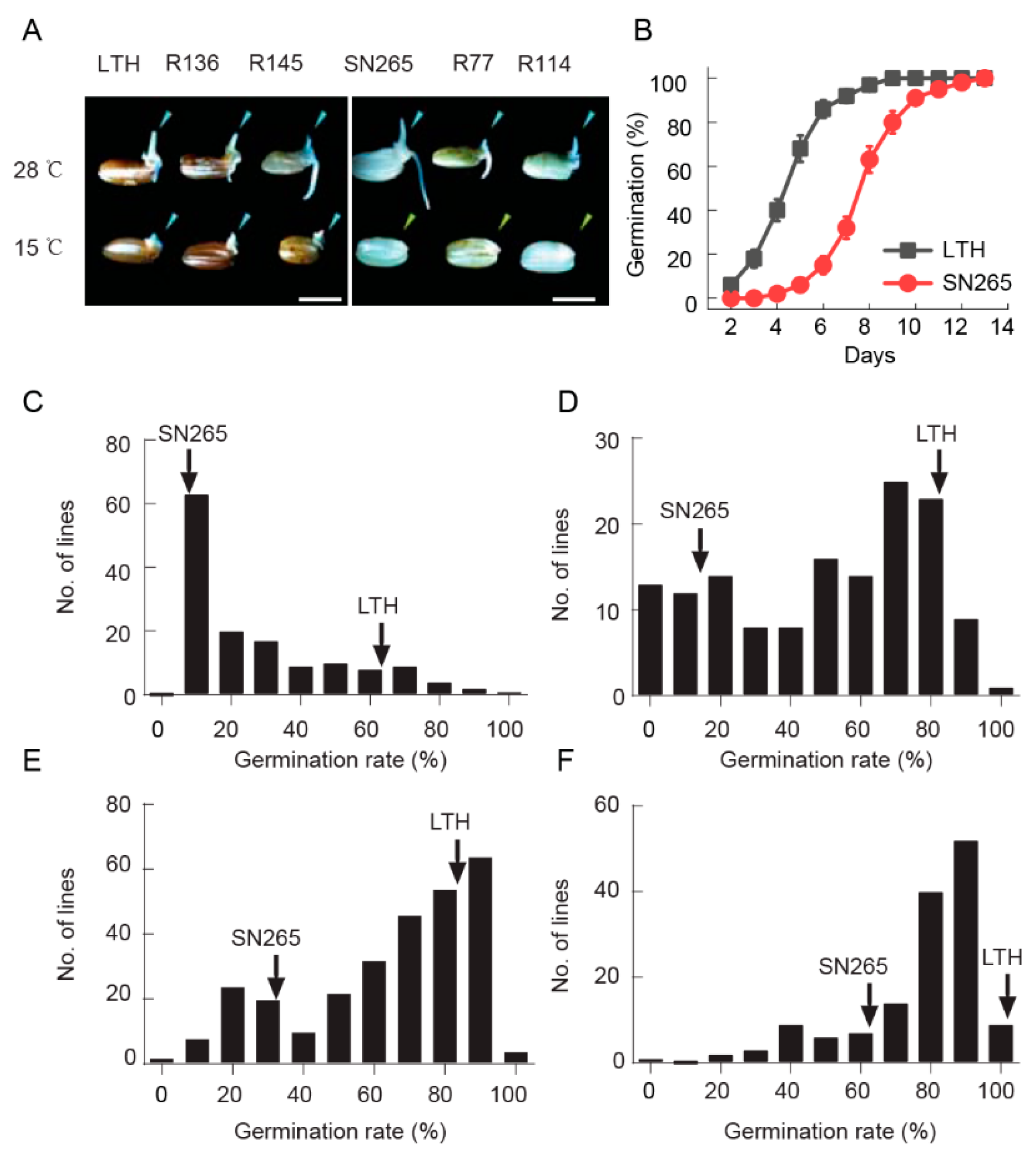
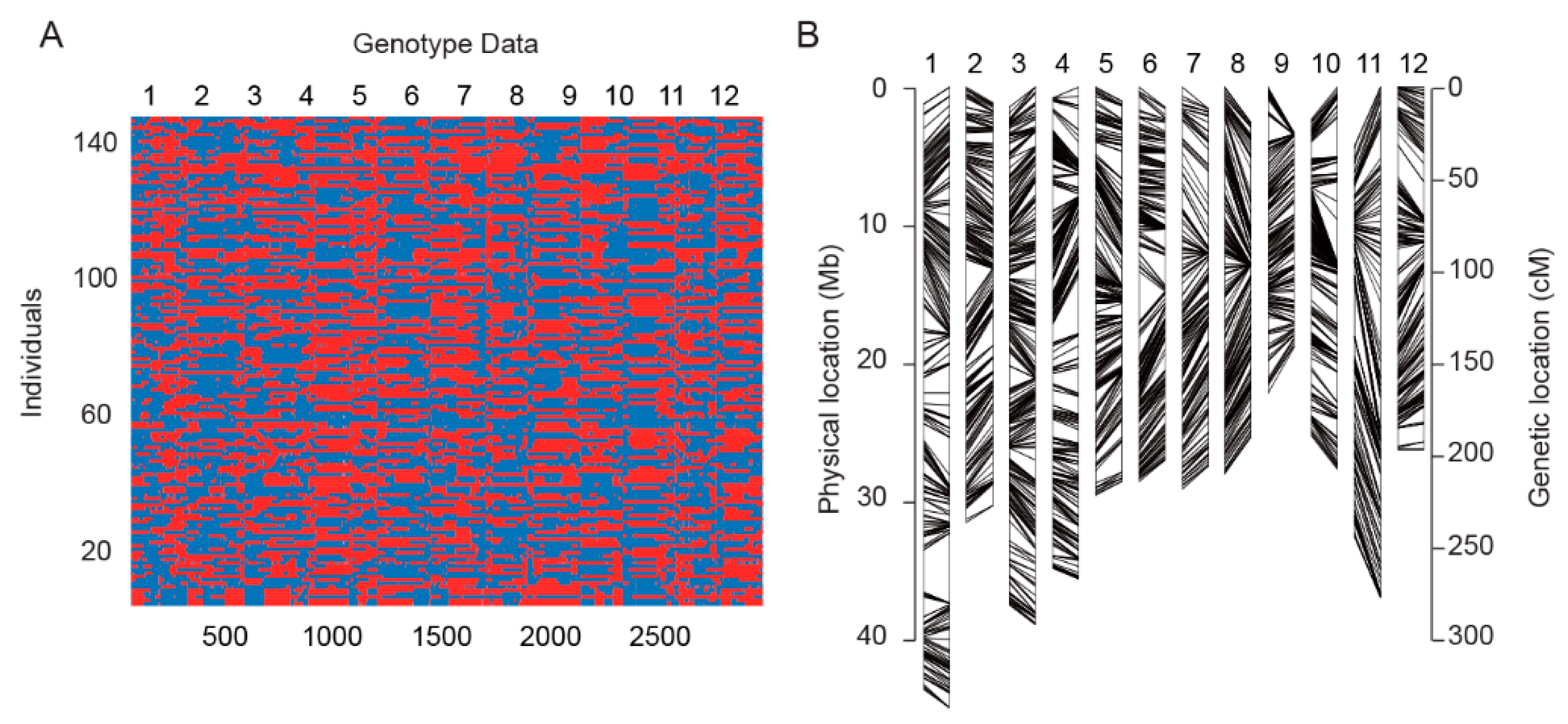
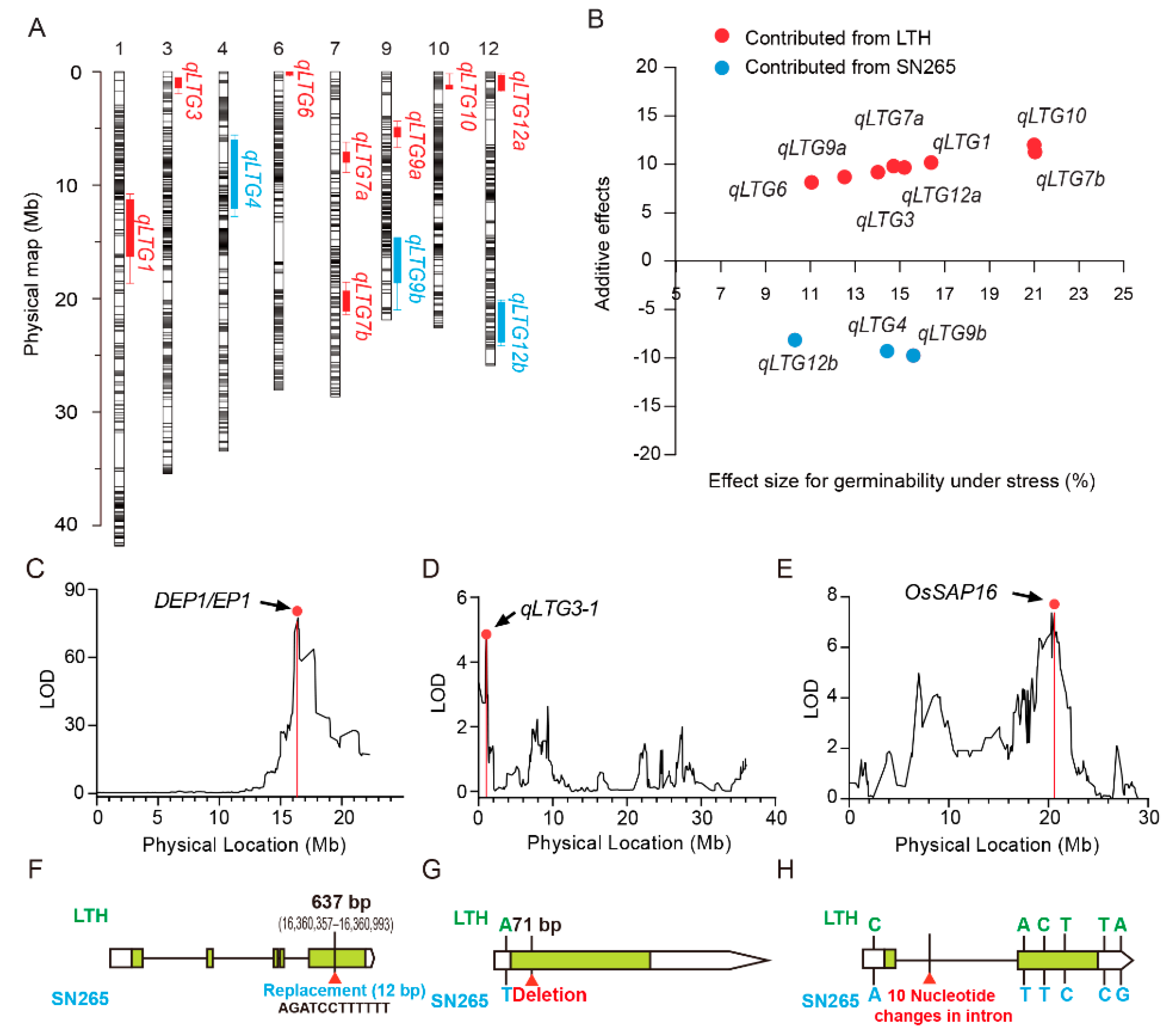
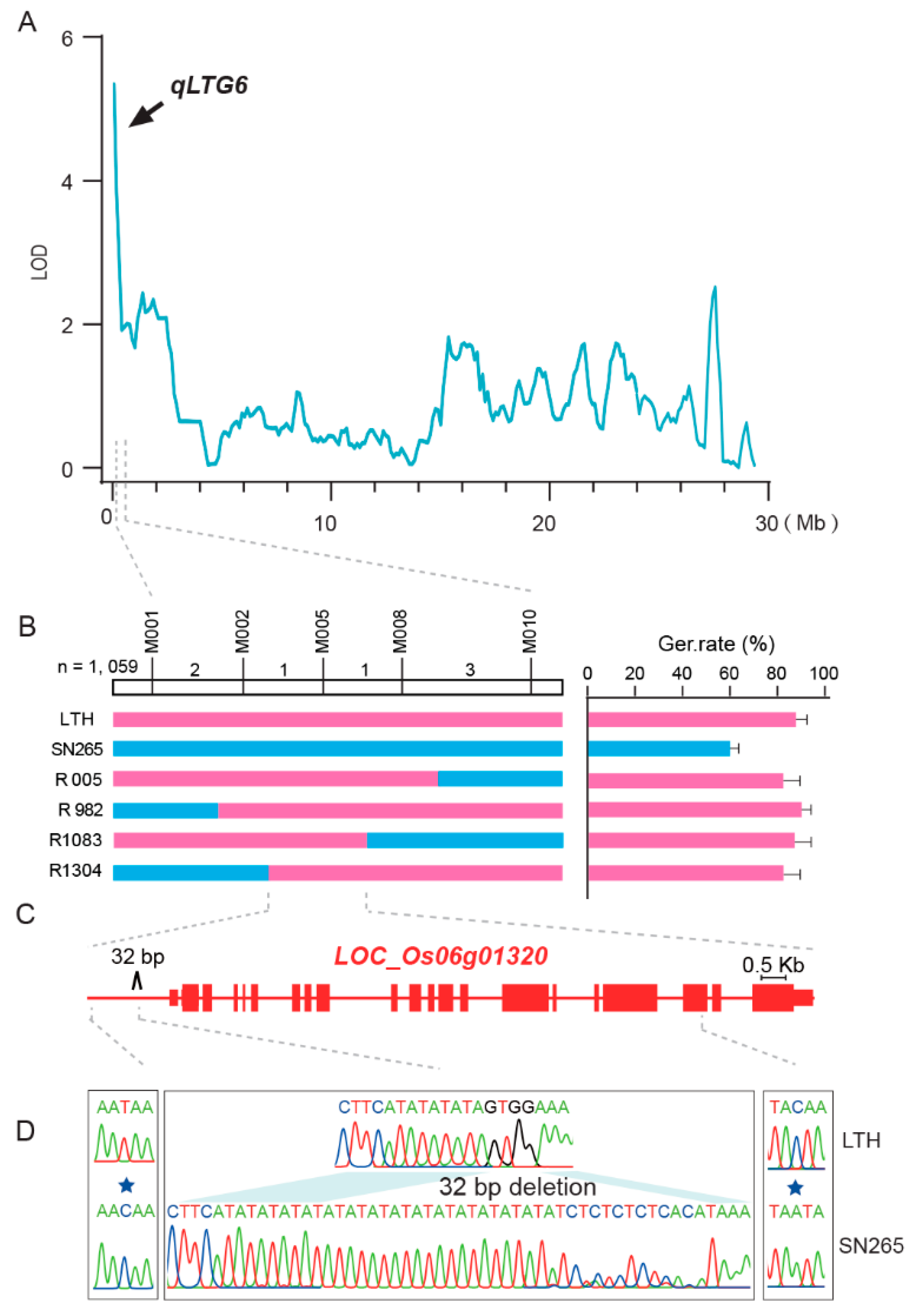
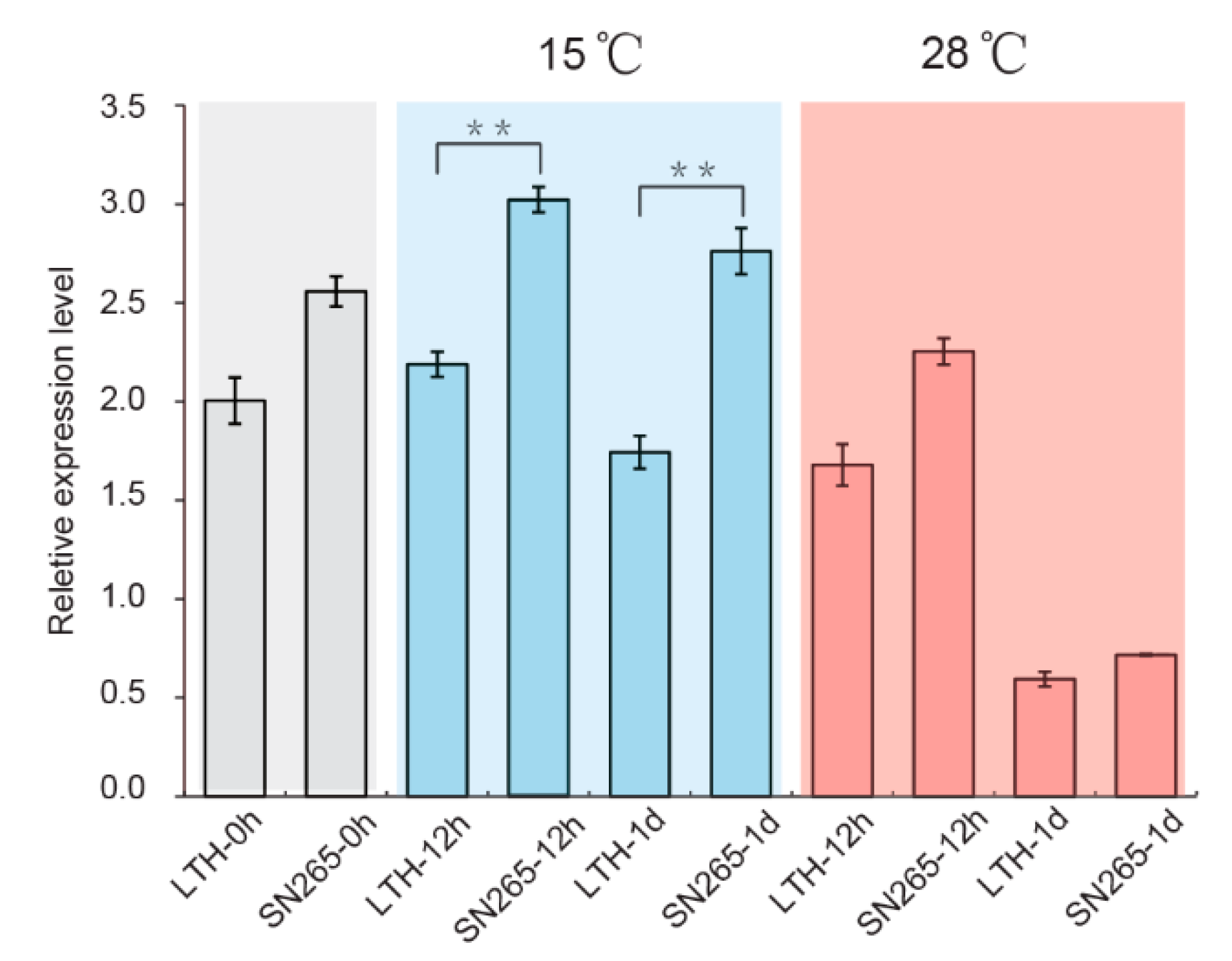
| Chr. a | No. Markers b | Genetic Distance (cm) | Physical Distance (Mb) | Avg Distance between Markers (cm/kb) | <1 Mb Gap | Min. Gap (kb) | Max. Gap (Mb) |
|---|---|---|---|---|---|---|---|
| 1 | 254 | 338.65 | 42.93 | 1.33/169.03 | 246 | 15.27 | 3.16 |
| 2 | 254 | 227.11 | 31.61 | 0.89/124.46 | 252 | 15.47 | 3.45 |
| 3 | 313 | 284.80 | 36.14 | 0.91/115.45 | 310 | 15.06 | 1.57 |
| 4 | 281 | 300.18 | 34.29 | 1.07/122.03 | 275 | 15.63 | 1.91 |
| 5 | 239 | 269.15 | 29.68 | 1.13/124.19 | 235 | 15.32 | 1.08 |
| 6 | 247 | 181.10 | 28.63 | 0.73/115.92 | 244 | 15.53 | 3.63 |
| 7 | 187 | 217.94 | 29.23 | 1.17/156.34 | 184 | 17.18 | 1.46 |
| 8 | 238 | 193.86 | 28.12 | 0.82/118.15 | 237 | 15.02 | 0.99 |
| 9 | 188 | 111.32 | 22.30 | 0.59/118.61 | 185 | 15.89 | 1.92 |
| 10 | 234 | 199.84 | 22.99 | 0.85/98.23 | 230 | 15.77 | 1.27 |
| 11 | 186 | 323.32 | 28.49 | 1.74/153.18 | 183 | 15.01 | 3.48 |
| 12 | 207 | 192.85 | 26.70 | 0.93/130.43 | 202 | 15.63 | 2.33 |
| QTL | Chr. a | Peak | QTL Interval | LOD c | Var (%) d | Add. e | Positive Allele | |||
|---|---|---|---|---|---|---|---|---|---|---|
| Pos. (cm) | Pos. (Mb) b | Linkage (cm) | Physical (Mb) | Location Interval (cm/Mb) | ||||||
| qLTG1 | 1 | 116.34 | 16.90 | 103.19–128.81 | 11.48–19.34 | 25.62/7.86 | 5.59 | 16.40 | 10.16 | LTH |
| qLTG3 | 3 | 3.95 | 1.10 | 0.00–10.78 | 0.00–1.31 | 10.78/1.31 | 4.71 | 14.02 | 9.18 | LTH |
| qLTG4 | 4 | 54.58 | 6.27 | 36.64–77.67 | 6.10–11.41 | 41.03/5.31 | 4.85 | 14.43 | −9.30 | SN265 |
| qLTG6 | 6 | 0.18 | 1.34 | 0.18–1.07 | 0.34–0.74 | 0.89/0.40 | 3.64 | 11.05 | 8.13 | LTH |
| qLTG7a | 7 | 104.99 | 8.88 | 87.28–107.84 | 6.98–9.21 | 20.56/2.23 | 4.98 | 14.72 | 9.80 | LTH |
| qLTG7b | 7 | 152.12 | 20.32 | 148.13–162.80 | 18.93–21.76 | 14.67/2.84 | 7.39 | 21.04 | 11.26 | LTH |
| qLTG9a | 9 | 4.31 | 6.07 | 4.35–8.38 | 5.91–6.83 | 4.03/0.92 | 4.17 | 12.53 | 8.68 | LTH |
| qLTG9b | 9 | 79.24 | 15.27 | 71.69–102.85 | 14.91–21.38 | 31.16/6.47 | 5.29 | 15.60 | −9.76 | SN265 |
| qLTG10 | 10 | 13.93 | 1.60 | 8.55–14.06 | 1.20–1.60 | 5.51/0.40 | 7.38 | 21.00 | 12.00 | LTH |
| qLTG12a | 12 | 6.17 | 0.87 | 4.72–16.25 | 0.86–2.35 | 11.53/1.49 | 5.14 | 15.20 | 9.65 | LTH |
| qLTG12b | 12 | 131.25 | 22.79 | 111.25–145.46 | 21.05–25.16 | 34.21/4.11 | 3.41 | 10.30 | −8.12 | SN265 |
| Molecular Marker | Primer Sequence (5′→′) |
|---|---|
| M001 | CTTCGCACTCCAGTCGCTCTCC GTTGAGGAGGTGTATGGGCTTGG |
| M002 | AGCTCACCAGGGACAACATCAAGG TTAACCAGCTCCGCCAGCATCC |
| M005 | CGCCACTGATCGATCTCCTCTCC CGAGCTGGCCTTCTTCCTTGG |
| M008 | AATTGATGCAGGTTCAGCAAGC GGAAATGTGGTTGAGAGTTGAGAGC |
| M010 | TGTTGGATTGGAATCGGAAAGC CTCTGCTGTGCTGTGCTGCTAGG |
| Name | Location | Protein |
|---|---|---|
| LOC_Os06g01250 | 163205–165539 | Cytochrome P450 |
| LOC_Os06g01260 | 167364–174331 | Glutathione gamma-glutamylcysteinyltransferase 1 |
| LOC_Os06g01270 | 178580–178343 | Expressed protein |
| LOC_Os06g01280 | 180215–181423 | Retrotransposon protein |
| LOC_Os06g01290 | 182104–184623 | Expressed protein |
| LOC_Os06g01304 | 185692–191452 | Spotted leaf 11 |
| LOC_Os06g01320 | 195018–208583 | Chromodomain, helicase/ATPase, and DNA-binding domain (CHD) proteins |
| QTL | Chr. a | QTL interval | Prior near QTLs Location | Reference |
|---|---|---|---|---|
| Physical (Mb) | Physical (Mb) | |||
| qLTG1 | 1 | 11.48–19.34 | qCTGERM1-5 (12.71) | [31] |
| qLTG3 | 3 | 0.00–1.31 | qLTG3-1 (0.22) | [9] |
| qLTG4 | 4 | 6.10–11.41 | qLTG-4 (6.58–13.64) | [32] |
| qLTG6 | 6 | 0.34–0.74 | qLTG-6 (0.65–2.69) | [33] |
| qLTG7a | 7 | 6.98–9.21 | qCTGERM7-1 (10.46–10.65) | [31] |
| qLTG7b | 7 | 18.93–21.76 | qLTG7 (20.16–22.55) | [34] |
| qGR-7 and qGI-7(20.35–21.59) | [35] | |||
| qCTGERM7-4 (19.59–20.26) | [31] | |||
| qLTG-7 (16.88–22.52) | [36] | |||
| OsSAP16 (22.93) | [10] | |||
| qLTG9a | 9 | 5.91–6.83 | ||
| qLTG9b | 9 | 14.91–21.38 | qLTG-9 (12.29–18.90) | [32] |
| qLTG-9 (11.81–15.32) | [33] | |||
| qLTG10 | 10 | 1.20–1.60 | qCTGERM10-1 (1.40–1.53) | [31] |
| qLTG12a | 12 | 0.86–2.35 | qLTG12a (0.75) | [37] |
| qLTG-12 (2.43–3.19) | [38] | |||
| qLTG12b | 12 | 21.05–25.16 | qCTGERM12-1 (24.89–24.90) | [31] |
| qGR-12(22.78–25.15) | [10] | |||
| qLTG12 (24.52–25.08) | [36] | |||
| qLTG-12 (24.52–25.08) | [39] |
© 2020 by the authors. Licensee MDPI, Basel, Switzerland. This article is an open access article distributed under the terms and conditions of the Creative Commons Attribution (CC BY) license (http://creativecommons.org/licenses/by/4.0/).
Share and Cite
Jiang, S.; Yang, C.; Xu, Q.; Wang, L.; Yang, X.; Song, X.; Wang, J.; Zhang, X.; Li, B.; Li, H.; et al. Genetic Dissection of Germinability under Low Temperature by Building a Resequencing Linkage Map in japonica Rice. Int. J. Mol. Sci. 2020, 21, 1284. https://doi.org/10.3390/ijms21041284
Jiang S, Yang C, Xu Q, Wang L, Yang X, Song X, Wang J, Zhang X, Li B, Li H, et al. Genetic Dissection of Germinability under Low Temperature by Building a Resequencing Linkage Map in japonica Rice. International Journal of Molecular Sciences. 2020; 21(4):1284. https://doi.org/10.3390/ijms21041284
Chicago/Turabian StyleJiang, Shukun, Chao Yang, Quan Xu, Lizhi Wang, Xianli Yang, Xianwei Song, Jiayu Wang, Xijuan Zhang, Bo Li, Hongyu Li, and et al. 2020. "Genetic Dissection of Germinability under Low Temperature by Building a Resequencing Linkage Map in japonica Rice" International Journal of Molecular Sciences 21, no. 4: 1284. https://doi.org/10.3390/ijms21041284
APA StyleJiang, S., Yang, C., Xu, Q., Wang, L., Yang, X., Song, X., Wang, J., Zhang, X., Li, B., Li, H., Li, Z., & Li, W. (2020). Genetic Dissection of Germinability under Low Temperature by Building a Resequencing Linkage Map in japonica Rice. International Journal of Molecular Sciences, 21(4), 1284. https://doi.org/10.3390/ijms21041284






